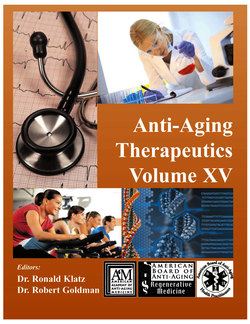Читать книгу Anti-Aging Therapeutics Volume XV - A4M American Academy - Страница 10
На сайте Литреса книга снята с продажи.
Misrepresentation in Competitive Sports
ОглавлениеAs an unfortunate consequence of media confusion and outright deception aiming to deliberately misrepresent anti-aging medical care, the reality of the clinical practice of hormone replacement therapy has become muddled. A recent Sports Illustrated article states5 that: “In the sports world, the term ‘anti-aging’ has often come to signify therapy that uses hormones – usually testosterone and HGH – and … DHEA.” This erroneous definition grossly misrepresents the legal and ethical physiological use of hormones and supplements as being synonymous with the inappropriate use of hormones for sports enhancement. The A4M is squarely opposed to this myopic interpretation of “anti-aging” and urges reference to the official definition of anti-aging medicine as presented above.
Any use of performance enhancing drugs or hormones banned from professional sports constitutes inappropriate misuse. It is a violation of the A4M Physician Member Code of Ethics to prescribe for the explicit purposes of performance enhancement. The A4M does not endorse or condone the use of any illicit substances for sports cheating. However, the A4M does support the continued availability of such substances to adult patients with objectively assessed hormone deficiencies. Such judicious use of HRT does not equate to a banned drug issue.
A4M’s physician co-founders Dr. Robert Goldman, MD, PhD, DO, FAASP, Chairman; and Dr. Ronald Klatz, MD, DO, President, are co-authors of Death In the Locker Room (1984), a first-ever expose of the illicit use of anabolic steroids in sports, and Grow Young with HGH (1997), a best-selling book that explored the clinical benefits of judicious and appropriate HGH therapy in deficient adults. Death in the Locker Room is widely regarded as the seminal text on the dangers of anabolic and performance enhancing substances in sports. Death in the Locker Room was the first book to alert the public and the medical community to such issues, and the book subsequently led directly to much of the drug testing, control, and educational programs now in-place across a number of professional sports and on the global level.
Statute6 21 U.S.C. § 333(e), a provision of the Food, Drug, and Cosmetic Act (FDCA), states, in pertinent part, that "whoever knowingly distributes, or possesses with intent to distribute, human growth hormone for any use in humans other than the treatment of a disease or other recognized medical condition, where such use has been authorized by [FDA] and pursuant to the order of a physician, is guilty of an offense punishable by not more than 5 years in prison." We need to take a critical look at the historical context and legislative intent of a law before we interpret it. The law did not originally address HGH. The 1988 law was written and passed regarding anabolic steroids. The legislative history of the statute shows an intent to focus on steroid trafficking to athletes, particularly adolescent athletes, amid increasing reports of amateur and professional sports doping and concerns about the 1988 Summer Olympics (at which, ironically, Canadian sprinter Ben Johnson's steroid positive ignited a global firestorm).
Dr. Goldman served as Special Adviser & Lecturer to the US Drug Enforcement Agency (DEA) Demand Reduction Education Programs nationally, as well as to the US Olympic Committee, spearheading the design of drug policy and testing procedures. In his activities with the DEA, Dr. Goldman was directly involved in an advisory capacity with the process that led to the creation of the Anabolic Steroid Control Act of 1990. “The Anabolic Steroid Control Act was never intended to restrict practicing physicians involved in the clinical treatment of hormone deficiency syndromes,” comments7 Dr. Goldman, who explains that: “Rather, this law was specifically directed to prevent the trafficking of anabolic steroids to athletes.”
The Anabolic Steroid Control Act of 1990 lifted steroids out of the FDCA and into the Controlled Substances Act. Congress was presented with the option of making HGH into a controlled substance, too. However, following expert medical testimony that HGH lacks the adverse psychological and physical effects of steroids, Congress chose not to take such a drastic approach to HGH.8,9 Instead, Congress took the lesser approach of inserting HGH, to replace steroids, in the FDCA law that was written to stop trafficking to cheating athletes. In fact, HGH was inserted as an afterthought, with no penalties mentioned, as editorial comment; there was no intention to criminalize its judicious use in the clinical setting by trained physicians. The focus of lawmakers and Congress has always been to address non-medical use, i.e., improper use by competitive elite athletes, sports people and teenagers. It is A4M's view that the JAMA commentary4 fails to understand or appreciate such legislative history and legislative purpose. A4M is advised that one of the authors of the JAMA commentary stated to United Press International (UPI) in reference to the statute, "They basically put in language that made it crystal clear that it is illegal to use growth hormone as an anti-aging intervention".10 This is a very odd and A4M believes, an incorrect statement, considering the fact that when the law was written, there were no anti-aging doctors or profession in existence. In fact, the anti-aging medical profession did not even exist until five years after the 1988 statute was enacted. The concept of HGH s an anti-aging drug did not exist until the problem of Rudman’s study.12
The Anabolic Steroid Control Act never intended to infringe upon physician freedoms to prescribe hormone therapy when clinically appropriate. It was specifically intended to prevent steroid trafficking in professional sports. Whereas education should have been a primary goal in implementing the Anabolic Steroid Control Act, instead an enforcement environment that granted limitless power unto itself was created. A multi-million dollar industry of drug testing was born and subsequently flourishes.
